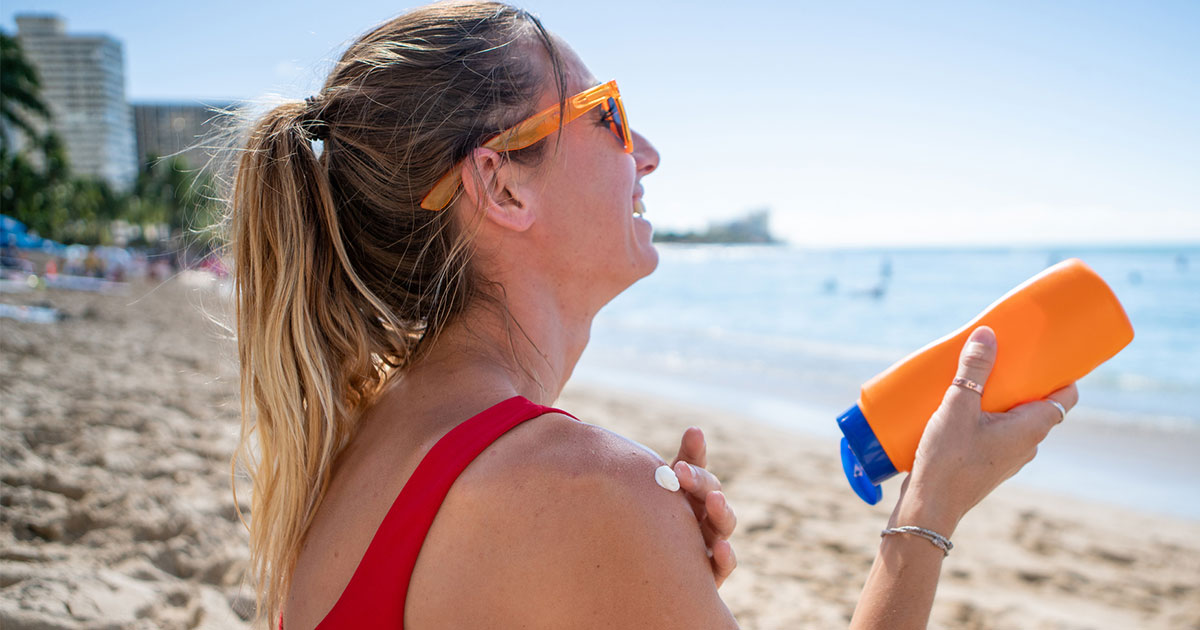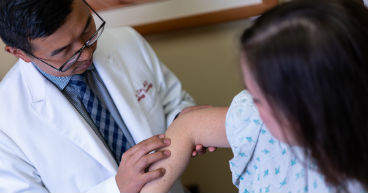
Ahh … summertime! Who doesn’t love the feeling of the sun’s warmth on your skin and the long, bright days of sunshine? You’re probably especially looking forward to your favorite warm-weather activities—bicycling, picnics, water sports and more—if you’ve been sheltering inside due to the COVID-19 pandemic and have the energy and ability to get out and about.
But before you go outdoors, you’ll want to protect yourself and your family from the type of sun exposure that can put you at risk. Skin cancer is the most common type of cancer in the United States, with more than 3.5 million people diagnosed each year. Basal cell cancer and squamous cell cancer, which together make up 95 percent of skin cancers, are caused by cumulative, long-term exposure to the sun’s ultraviolet (UV) rays. But UV exposure for even as little as 15 minutes may damage your skin.
Using an appropriate sunscreen is vital to protecting your skin, but many sunscreens don’t prevent all types of UV damage. High-energy UVB rays burn the skin—that’s the redness you can see—and play a role in causing cancer, but they make up just 3 to 5 percent of UV radiation. UVA rays, which are the majority, may not cause redness, but they penetrate skin tissue more deeply and can generate free radicals, which can damage your skin’s DNA, advance skin aging and cause skin cancer.
There’s a huge variety of sunscreens to choose from, and in recent years, clothing with UPF (ultraviolet protection factor) ratings have become increasingly popular. But before splurging on summer protection, be sure you’re aware of these sun-safety myths:
Myth: Higher SPFs give significantly more protection.
Most people think that sunscreen with an SPF (sun protection factor) of 100 provides more than triple the sun protection of an SPF 30. In reality, sunscreen with an SPF of 30 will block 97 percent of the sun’s rays. Higher SPFs, while more expensive, will block only 1 to 2 percent more, and no sunscreen can block 100 percent. The SPF also has no impact on the length of time sunscreen will protect you; the same duration applies for both low- and high-SPFs: typically two hours or less.
Myth: Any clothing will block the sun’s rays.
The type of clothing matters when it comes to sun safety. Darker and brighter colors absorb more UV rays, so they provide more sun protection than white or pastel shades. Also, heavier, denser fabrics with tighter weaves offer more protection than thin, lightweight fabrics with loose weaves. A white T-shirt, for example, doesn’t offer much defense, and when it’s wet, it offers even less.
Many new fabrics provide high-tech protection and breathability, which makes them a good choice for summer sports. Look for the UPF designation on labels for clothing and hats. The number indicates what fraction of the sun’s UV rays penetrates the fabric. A UPF of 30 to 49 offers very good protection, while UPF 50+ rates as excellent by the Skin Cancer Foundation.
The more skin you cover (high neck, long sleeves, pants), the better, and a hat with a wide brim all the way around (three inches or more) helps shade the eyes, ears, face and neck. Also wear UV-filtering sunglasses to protect your eyes.
Myth: Wearing sunscreen causes vitamin D deficiency.
When your skin is exposed to sunlight, it manufactures vitamin D. The sun’s UVB rays interact with a protein in the skin, converting it to vitamin D3, the active form of vitamin D. Vitamin D helps regulate the amount of calcium and phosphate in the body—nutrients needed to keep your bones, teeth and muscles healthy.
Even if you apply sunscreen well, it still allows 2 to 3 percent of the sun’s UVB to reach your skin, and your body only needs a little to produce vitamin D. “Studies have never found that everyday sunscreen use leads to vitamin D insufficiency,” an article published by the Skin Cancer Foundation states.
Myth: You can’t get burned if it’s cloudy.
It’s important to protect your skin from the sun even if it’s not particularly sunny outside. On cloudy days, up to 90 percent of the sun’s rays can still penetrate your skin. Since you don’t feel the heat as much, you may be tempted not to cover up or use sunblock. Don’t give in to that urge. you can still get a sunburn on a cloudy day. Also, if you’re near the water or sand, these elements reflect the sun, exposing your skin to additional indirect UV rays, and increasing your chances of getting a burn.
Myth: My makeup has sunscreen. That’s all I need.
Using a foundation with at least an SPF 30 on your face will give some sun protection, but it doesn’t work as well as traditional sunscreen. Since you only apply a light layer on your face and its consistency is thin, makeup with SPF will not protect you all day in the sun. You’re also not likely to apply foundation to your ears, throat, back of neck or other sun-prone areas. So even if your makeup has an SPF, be sure to use a traditional sunscreen as well.
Myth: It doesn’t matter what time you go out in the sun.
UV rays are strongest, and your risk of skin damage the greatest, when the sun is at its peak in the sky, from about 10 a.m. to 4 p.m. During these hours, even brief sun exposure may lead to a burn faster than other times of day, such as in the late afternoon or early morning. Of course, you can still get burned in the morning and early-evening hours. Try to avoid sun exposure during peak hours if you can. If not, try to stay in the shade, wear protective clothing and use an appropriate sunblock.
Myth: You don’t need sunscreen if you have dark-colored skin.
Dark-colored skin will not burn as easily as light-colored skin, but the sun can still lead to skin damage and burns with excessive exposure. The American Academy of Dermatology recommends that everyone, regardless of skin tone, wear sunscreen because “anyone can get skin cancer, regardless of age, gender or race.”
Myth: Sunlight doesn’t penetrate through windows.
While UVB rays are blocked by glass, UVA rays, which may increase your risk of skin cancer, are not. If you spend a lot of time exposed to window-filtered sun (during a long car commute or if your desk is next to a window, for example), your skin may still be damaged as a result. The windows on airplanes, trains and buses also allow UVA rays to pass through. When traveling, be sure you and your family use sun protection.
Myth: All sunscreens are created equal.
Sunscreens typically contain either chemicals, such as oxybenzone, to absorb the sun’s rays, or minerals, such as titanium dioxide, that block them. Oxybenzone, a chemical an Environmental Working Group (EWG) report says is present in more than 40 percent of sunscreens, has been linked to hormone disruption and cell damage that may lead to cancer. EWG also reports that retinyl palmitate (a form of vitamin A), may speed the development of skin tumors when applied to skin exposed to sunlight.
Currently, just two sunscreen ingredients are indicated by the U.S. Food and Drug Administration (FDA) as being “generally recognized as safe and effective”: zinc oxide and titanium dioxide. The FDA had planned on updating regulatory requirements for sunscreens in 2019, but its research is still ongoing. EWG has reviewed 1,300 over-the-counter products and published an annual guide to sunscreens.
More tips for finding a safe and effective sunscreen
Look for broad-spectrum SPF 15-50. Sunscreens labeled as “broad spectrum” have ingredients that protect you from both UVA and UVB rays.
Look for water-resistant products: Sunscreens can’t claim to be waterproof but can be labeled as water resistant for either 40 or 80 minutes. It’s best to reapply after swimming or sweating, regardless of the time since your last application.
Look for mineral-based sunscreens: These contain zinc oxide and/or titanium dioxide as active ingredients. Mineral-based sunscreens are less likely to irritate sensitive skin as well.
Avoid products with oxybenzone and the vitamin A derivative retinyl palmitate.
Avoid spray and loose powder sunscreens: They may cause health concerns if inhaled and also make it difficult to determine whether your skin is adequately covered. Stick to lotion or cream sunscreens instead.
Avoid super-high SPFs: SPFs higher than 50 may offer false reassurance that you can stay in the sun longer than is safe. Some of these high-SPF products protect against UVB radiation, which causes burns, but not UVA.
Experts agree that sunscreen should be only one part of your summer defense strategy. You also should plan outdoor activities for early morning or late afternoon, stay in the shade during peak sunlight hours, and wear lightweight long-sleeve clothing, pants, a hat and sunglasses with UV light protection. And if you spot a suspicious mark on your skin, get it checked out by your physician.

